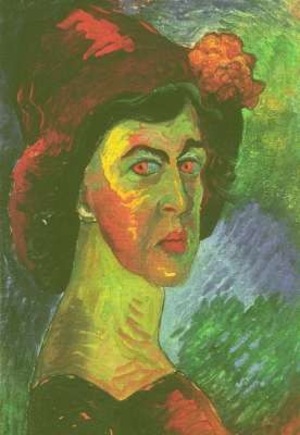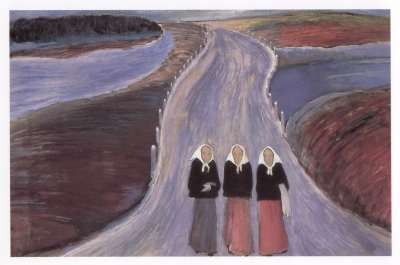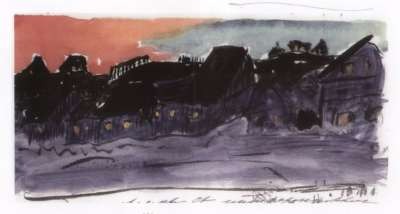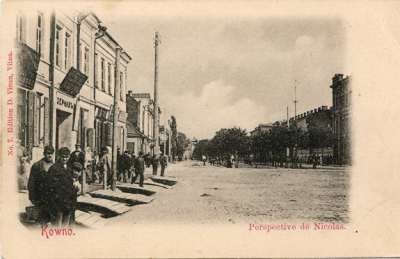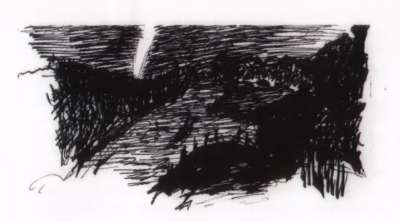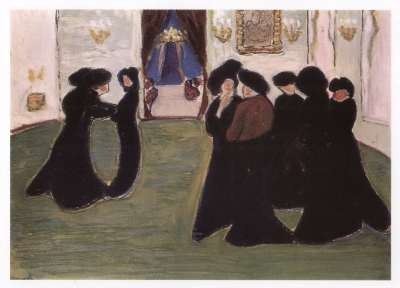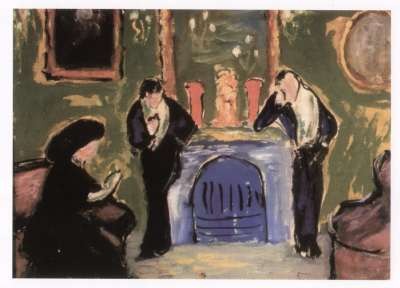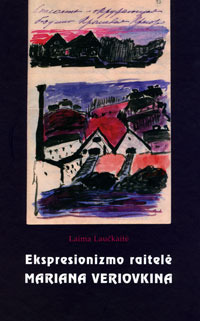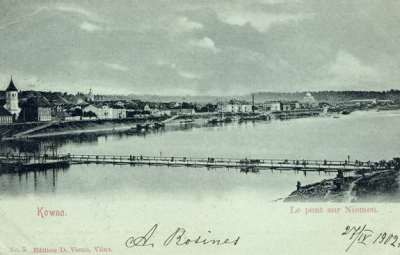MARIANA VERIOVKINA AND KAUNAS 0
Rasa Andriušytė
www.kamane.lt, 2010 01 18
In brief: As if she had waited for the possibility to commemorate the one hundredth anniversary of the artist Mariana Veriovkina’s arrival in Kaunas (1909), the art critic Laima Laučkaitė presented her book “Rider of Expressionism Mariana Veriovkina” (Vilnius: Institute of Culture, Philosophy and Art, 2007) at the end of December of 2009. The book is a real treasure for people interested in Kaunas history and a good sedative for the ones suffering from feeling of province. One should remember that avant-garde western art, a collection of modern paintings of Mariana Veriovkina (1860-1938) and Aleksej Javlenski (1864-1941) was exhibited at Kaunas governor’s office one hundred years ago.
Mariana Veriovkina. Self-portrait. 1910. State Lenbachhaus Gallery, Munich, Germany. Photo from the book of L.Laučkaitė “Rider of Expressionism Mariana Veriovkina”
M.Veriovkina grew up in Lithuania, later she lived in St.Petersburg and attended the studio of Ilja Repin. She started studies in Munich in 1896 and came to Russia and Lithuania only as a guest from this time. She was one of the most active participants of the new artistic movement Neue Künstlervereinigung (New Union of Artists) and group of expressionists Der Blaue Reiter (Blue Rider) in Munich. Her close friends were a company of Russian, German, French and Swiss artists who searched for avant-garde art methods and who found them. These were Gabriele Munter and Vasilij Kandinski, Lily and Paulius Klee, Aleksej Javlenski, Alfred Kubin, Robert Delaunay, and other famous representatives of western modernism.
Three Lithuanian towns Vilnius, Utena and Kaunas are mentioned in books about this famous and cosmopolitan personality. M.Veriovkina and Kaunas is one of the unrealised or perhaps forgotten facts of multinational Kaunas culture history of the 20th century, similarly to episodes of Mark Chagall, Mstislav Dobuzinski or Fiodor Shaliapin. There are many descriptions and drawings of Kaunas in letters written by M.Veriovkina. There are plenty of Lithuanian motifs in her works, and titles of paintings remind to visitors of European museums about the relations of the artist with Lithuania: “The Road (Three Lithuanian Women)”, “A Township in Lithuania” (both 1910), “St. Ann’s Church in Vilnius”, “Police Post in Vilnius” (both 1914).
Mariana Veriovkina. “The Road (Three Lithuanian Women)”. 1910. Askona Town Modern Art Museum, Switzerland. Photo from the book of L.Laučkaitė “Rider of Expressionism Mariana Veriovkina”
Mariana Veriovkina. “A Township in Lithuania”. 1910. Askona Town Modern Art Museum, Switzerland. Photo from the book of L.Laučkaitė “Rider of Expressionism Mariana Veriovkina”
Kaunas in expressionist’s eyes
“Kaunas is a treasure to an artist," M.Veriovkina wrote in her letter to the painter A.Javlenski in 1910 looking at Žaliakalnis hill through the window in her room at Kaunas governor’s office. She compared Kaunas with graphic views of her friend, Austrian expressionist Alfred Kubin.
Mariana Veriovkina. “Nemunas Quay in the Evening”. 1910. Drawing from the author’s letter to Aleksej Javlenski. Lithuanian National M. Mažvydas Library. Photo from the book of L.Laučkaitė “Rider of Expressionism Mariana Veriovkina”
M.Veriovkina looked at the world as an expressionist; therefore, her letters with stories about Kaunas are full of vivid and hypertrophied views. The drawings of Kaunas are full of the expressionist’s feelings rendered by dark and bright colours. The environment of the city is transformed artistically but still recognisable – low rows of houses at the Nemunas, Žaliakalnis slope at the synagogue, St. Michael’s Church. She drew even a comet above Kaunas in one letter to A.Javlenski.
The crossing of the present Šv. Gertrūdos Street and Laisvės Alley at the beginning of the 20th century. Postcard from the website of Kaunas County Public Library www.kvb.lt.
Mariana Veriovkina. “The Show of a Comet above Kaunas”. 1910. Drawing from the author’s letter to Aleksej Javlenski. Lithuanian National M. Mažvydas Library. Photo from the book of L.Laučkaitė “Rider of Expressionism Mariana Veriovkina”
The paintings of M.Veriovkina “Ladies in Black", “Meeting” (both 1910) picture the interiors of the governor’s office building. The scenes in the dining-room and White Hall captured by M.Veriovkina enrich the information about life that took place here.
Mariana Veriovkina. “Ladies in Black". 1910. Private property. Photo from the book of L.Laučkaitė “Rider of Expressionism Mariana Veriovkina”
We know about the former fireplace that was located on the first floor only from researches of the art historian Nijolė Lukšionytė until now. Meanwhile, the painting of M.Veriovkina “At the Fireplace” (1910) pictures the blue hearth of the governor’s office as well as interior details: vases on the hearth, paintings and tapestry.
Mariana Veriovkina. “At the Fireplace”. 1910. Vysbaden Museum, Germany. Photo from the book of L.Laučkaitė “Rider of Expressionism Mariana Veriovkina”
A Look to the Book
Laima Laučkaitė. “Rider of Expressionism Mariana Veriovkina”. Vilnius, 2007. Artist of the cover Andrius Surgailis
The text of L.Laučkaitė locks interest from the first pages. The personality of M.Veriovkina and situation of researches on her creative works is reviewed in a concentrated and thorough manner in the introduction of the book. The story of the “meeting” of the researcher and her object is described.
There is much of interesting and rare information about Lithuania and Russia of the 19th century in L.Laučkaitė’s book. It is a description of cultural and political situation from close by, stories about people’s life in Vilnius, Utena, Kaunas, cravings of youth of M.Veriovkina, thoughts of a girl and a woman, presentation of art phenomena and personalities of West Europe.
Discerning evaluations of M.Veriovkina’s works are intertwined with reality and daily stories of Tsar’s Russia in the book, which encompasses feelings, concerns and manners of inhabitants of the multinational empire: Russians, Poles, Lithuanians, Jews.
L.Laučkaitė is one of the few Lithuanian art researchers, in whose studies the wider, more cosmopolitan understanding of Lithuanian art history is evident. Therefore, this book of L.Laučkaitė may stand alongside other books of art and literature criticism of Jolita Mulevičiūtė, Jolanta Širkaitė, Mindaugas Kvietkauskas and Eugenija Vaitkevičiūtė, which have broadened the Lithuanian cultural horizon.
A Bridge across the Nemunas in Kaunas. Beginning of the 20th century. Postcard from the website of Kaunas County Public Library www.kvb.lt.








